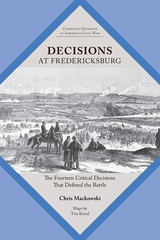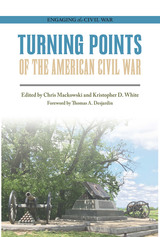
In the fall of 1862, after a leadership shake-up initiated by Lincoln, Gen. Ambrose Burnside assumed command of the Army of the Potomac and developed an aggressive plan to attack the Confederate capital of Richmond. However, in order to reach Richmond, Burnside had to march through Fredericksburg, where Gen. Robert E. Lee’s Army of Northern Virginia was well entrenched. After crossing the Rappahannock River under enemy fire, Burnside and his troops engaged Lee’s army within the city, then launched a futile frontal assault against a heavily fortified ridge west of Fredericksburg. The end result was a decisive victory for the Confederacy, as the Union army suffered more than double the number of casualties as its foes. Burnside would resign a month later but would resurface as war in the Western Theater grew heated.
Decisions at Fredericksburg explores the critical decisions made by Confederate and Union commanders during the battle and how these decisions shaped its outcome. Rather than offering a history of the battle, Chris Mackowski hones in on a sequence of critical decisions made by commanders on both sides of the contest to provide a blueprint of the Battle of Fredericksburg at its tactical core. Identifying and exploring the critical decisions in this way allows students of the battle to progress from knowledge of what happened to a mature grasp of why events happened.
Complete with maps and a driving tour, Decisions at Fredericksburg is an indispensable primer, and readers looking for a concise introduction to the battle can tour this sacred ground—or read about it at their leisure—with key insights into the campaign and a deeper understanding of the Civil War itself.
Decisions at Fredericksburg is the eleventh in a series of books that will explore the critical decisions of major campaigns and battles of the Civil War.

From Ulysses S. Grant’s Memoirs to Abraham Lincoln: Vampire Hunter, from Roots to Ken Burns’s The Civil War, from “Dixie” to “Ashokan Farewell,” and from Civil War photography to the Gettysburg Cyclorama, trendy and well-loved depictions of the Civil War are the subjects of twenty contributors who tell how they and the general public have been influenced by them. Sarah Kay Bierle examines the eternal appeal of Gone with the Wind and asks how it is that a protagonist who so opposed the war has become such a figurehead for it. H. R. Gordon talks with New York Times–bestselling novelist Jeff Shaara to discuss the power of storytelling. Paul Ashdown explores ColdMountain’s value as a portrait of the war as national upheaval, and Kevin Pawlak traces a shift in cinema’s depiction of slavery epitomized by 12 Years a Slave. Tony Horwitz revisits his iconic Confederates in the Attic twenty years later.
The contributors’ fresh analysis articulates a shared passion for history’s representation in the popular media. The variety of voices and topics in this collection coalesces into a fascinating discussion of some of the most popular texts in the genres. In keeping with the innovative nature of this series, web-exclusive material extends the conversation beyond the book.

READERS
Browse our collection.
PUBLISHERS
See BiblioVault's publisher services.
STUDENT SERVICES
Files for college accessibility offices.
UChicago Accessibility Resources
home | accessibility | search | about | contact us
BiblioVault ® 2001 - 2024
The University of Chicago Press









